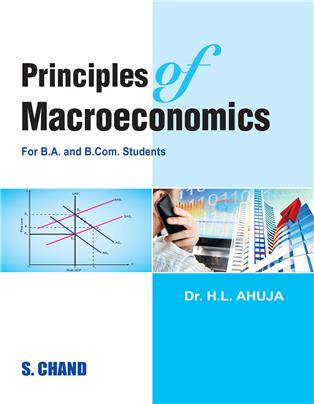
Author : H L Ahuja
Price : 725.00 580.00
Designed for the undergraduate students of economics, commerce and management, this textbook thoroughly explains the principles of macroeconomics. It provides insights into the important macroeconomic issues, such as determination of output, employment, interest rates and inflation. This textbook discusses Classical and Keynesian theories of macroeconomics as well as aptly incorporates Post-Keynesian developments in various aspects of macroeconomics. Further it discusses, at appropriate places, the relevance and applicability of various macroeconomic theories for the developing countries. This textbook also explains and critically evaluates the post-Keynesian theories of consumption function namely, Kuznet's consumption function, Modigliani's life cycle hypothesis and much more.
PART I: MACROECONOMICS: THEORY OF INCOME AND EMPLOYMENT
PART II: IS-LM MODEL, INFLATION-UNEMPLOYMENT TRADE-OFF : PHILLIPS CURVE
13. IS-LM Curves Model
14. Inflation-Unemployment Trade-off: Phillips Curve and Rational Expectations Theory
PART III: MONETARY DEMAND AND SUPPLY
15. Money: Nature and Functions
16. Credit and Commercial Banking
17. Central Banking
18. Objectives and Instruments of Monetary Policy
Appendix to Chapter 18: Role of Monetary Policy in Economic Growth
19. Supply of Money and its Determinants
20. Demand for Money and Keynes's Liquidity Preference Theory of Interest
Appendix to Chapter 20: Post-Keynesian Theories of Demand for Money
PART IV: MONEY, PRICES AND INFLATION
21. Money and Prices: Quantity Theory of Money
22. Keynes's Theory of Money and Prices
23. Friedman's Restatement of Quantity Theory of Money
24. Inflation and Hyperinflation: Causes, Social Costs and Effects
Appendix to Chapter 24: Measurement of Inflation and Price Indices WPI and CPI
PART V: BUSINESS CYCLES AND MACROECONOMIC POLICY
25. Analysis of Business Cycles
26. Economic Stabilisation: Fiscal Policy
27. Economic Stabilisation: Monetary Policy
PART VI: OPEN ECONOMY MACROECONOMICS
28. National Income in an Open Economy and Foreign Trade Multiplier
29. Balance of Payments
30. Foreign Exchange Rate
PART VII: GOVERNMENT AND THE MACROECONOMY: PUBLIC FINANCE AND FISCAL POLICY
31. Public Finance: Public Expenditure
32. Public Revenue: Taxation and Budget
33. Incidence of Taxation
34. Fiscal Policy and Economic Growth in a Developing Country
PART VIII: ECONOMIC GROWTH
35. Economic Growth and its Determinants
36. Harrod-Domar Model of Growth
37. Neoclassical Growth Model
Appendix to PART VIII: Sen vs. Bhagwati: Debate on Growth, Poverty and Distribution
Be the first one to review
Your email address will not be published.
Your rating for this book :
S Chand And Company Limited
Building No. D-92, Fifth Floor,
Sector – 02, Noida 201301,
Uttar Pradesh (India)
1800 1031 926